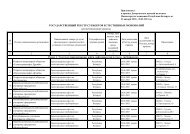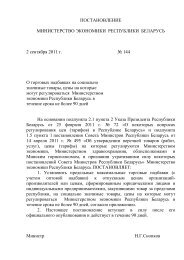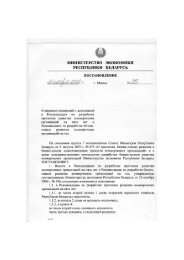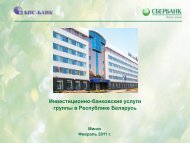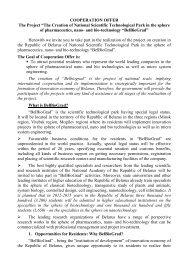2. <strong>The</strong> history of the CES origin<strong>The</strong> <strong>Common</strong> <strong>Economic</strong> <strong>Space</strong> originated in 1996, when by virtue of the Treaty onExtending the integration in economic and humanitarian areas of March 29, 1996, signed by theRepublic of Belarus, the Republic of Kazakhstan, the Kyrgyz Republic and the RussianFederation, the parties decided to create a Community of integrated states.By virtue of Customs Union and <strong>Common</strong> economic space Agreement of February 26,1999, signed by the Republic of Belarus, the Republic of Kazakhstan, the Kyrgyz Republic, theRepublic of Tajikistan and the Russian Federation, the parties undertook obligations to completethe formation of the Customs Union and to create the <strong>Common</strong> <strong>Economic</strong> <strong>Space</strong> on its basis.<strong>The</strong> Republic of Belarus, the Republic of Kazakhstan, the Kyrgyz Republic, the RussianFederation and the Republic of Tajikistan signed the Treaty on the establishment of the Eurasian<strong>Economic</strong> Community (hereinafter - EurAsEC) on October, 10, 2000. <strong>The</strong> purpose of EurAsEC,in accordance with Clause 2 of the Treaty, was effective promotion of the formation of theCustoms Union and the <strong>Common</strong> <strong>Economic</strong> <strong>Space</strong> by the Contracting Parties.It was stipulated by the Treaty on the formation of the <strong>Common</strong> <strong>Economic</strong> <strong>Space</strong>, whichwas signed by the Republic of Belarus, the Republic of Kazakhstan, the Russian Federation andUkraine on September, 19, 2003, that the parties commence the process of formation of the CES.Ukraine, while signing this Agreement, made a caveat that it will take part in the formation andfunctioning of the <strong>Common</strong> economic space within the bounds of the Ukrainian Constitution.After signing the Treaty on the <strong>Common</strong> <strong>Economic</strong> <strong>Space</strong>, the parties started creating theregulatory and legal framework of the CES. <strong>The</strong> Plan of Actions on the formation of the<strong>Common</strong> <strong>Economic</strong> <strong>Space</strong> of Belarus, Kazakhstan and the Russian Federation for 2010 – 2011was validated on December 19, 2009 by the Decree of the Interstate Eurasian <strong>Economic</strong>Community Council.<strong>The</strong> next stage of CES development was signing the Declaration of the Eurasian economicintegration on November, 18, 2011. In accordance with the Declaration, the CES is based on theprinciples of abidance by the universally recognized norms of the international law, includingrespect for sovereignty and equality of states, the assertion of fundamental human rights andfreedoms, the rule of law and market economy. In its practical cooperation the states of the CESare determined to be guided by the rules and regulations of the World Trade Organization. <strong>The</strong>Declaration reaffirms the importance of joining it of all three states.In addition, the Declaration stipulates the desire of the Parties to complete the codificationof the international treaties, which make up the regulatory and legal framework of the CustomsUnion and the CES, till January 1, 2015.A month later, on December, 19, 2011, the decision on bringing into force a package of 17international treaties that form the CES starting from January, 1, 2012, was approved.6
3. <strong>The</strong> Customs Union and the <strong>Common</strong> <strong>Economic</strong> <strong>Space</strong>Despite the fact that the <strong>Common</strong> <strong>Economic</strong> <strong>Space</strong> and the Customs Union have 3 memberstates: Belarus, Kazakhstan and the Russian Federation - the differences between these unitsexist.It becomes clear from the definition of the Customs Union, provided in Clause 1 of theTreaty on establishment of a single customs territory and formation of the Customs Union as ofOctober, 6, 2007, that the Customs Union is a form of trade and economic integration of theParties, which provides a single customs territory, within which in the mutual trade inproducts originated from a single customs territory, as well as from the third countries andwhich are in free circulation on this customs territory, customs duties and economic limitations,except for special protective, antidumping and countervailing measures are not applied.Herewith, the Parties apply a single customs tariff and other single measures, regulating the tradein products with third countries.<strong>The</strong> key features of the Customs Union is a single customs territory and commonprinciples of commodity circulation on the territory. Thus, the Customs Union is the first step toeconomic integration of the parties.<strong>The</strong> Treaty on the Customs Union and the <strong>Common</strong> <strong>Economic</strong> <strong>Space</strong> of February, 26,1999 states that "<strong>The</strong> Parties assume responsibilities to complete the formation of the CustomsUnion and to create the <strong>Common</strong> <strong>Economic</strong> <strong>Space</strong> on its basis."<strong>The</strong> <strong>Common</strong> <strong>Economic</strong> <strong>Space</strong> as the next step of economic integration is created on thebasis of the Customs Union, but the CES already stipulates far more issues which the Partiesstrive to resolve together.Thus, in accordance with the definition, provided in the Treaty on the Customs Union andthe <strong>Common</strong> <strong>Economic</strong> <strong>Space</strong> of February, 26, 1999, the CES is the space, composed of theterritories of the Parties, where one-type mechanisms of economy regulation, based on marketprinciples and application of harmonized law, function, where a single infrastructure exists andwhere coordinated tax, fiscal, monetary, trade and customs policy is implemented to ensurethe free movement of goods, services, capital and labour force.Thus, within the CES, additional prerequisites for ensuring the free movement of not onlygoods but also capital and labour force are being created. Mainly for this purpose the parties -members of the CES conduct a common policy, coordinated in the regulatory framework of theCES.7



